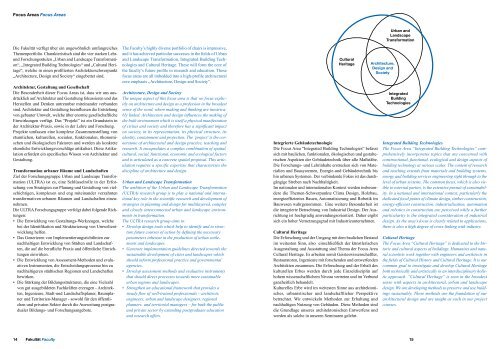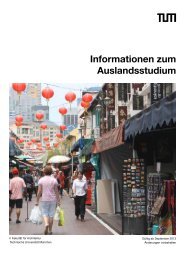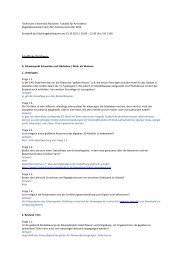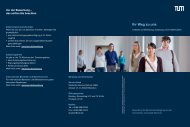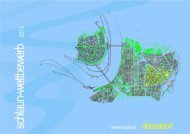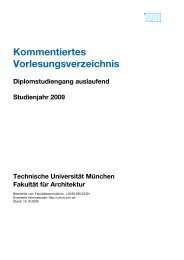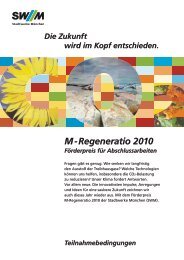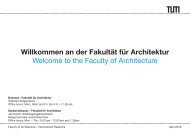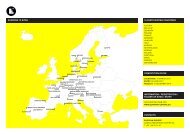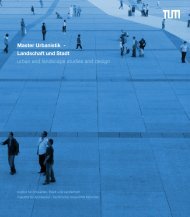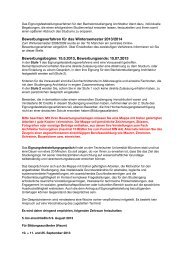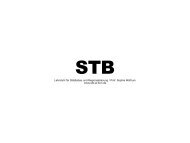Institute Institutes - Fakultät für Architektur - TUM
Institute Institutes - Fakultät für Architektur - TUM
Institute Institutes - Fakultät für Architektur - TUM
Sie wollen auch ein ePaper? Erhöhen Sie die Reichweite Ihrer Titel.
YUMPU macht aus Druck-PDFs automatisch weboptimierte ePaper, die Google liebt.
Focus Areas Focus Areas<br />
Die <strong>Fakultät</strong> verfügt über ein ungewöhnlich umfangreiches<br />
Themenportfolio. Charakteristisch sind die vier starken Lehr-<br />
und Forschungssäulen „Urban and Landscape Transformation“,<br />
„Integrated Building Technologies“ und „Cultural Heritage“,<br />
welche in einen profilierten <strong>Architektur</strong>schwerpunkt<br />
„Architecture, Design and Society“ eingebettet sind.<br />
<strong>Architektur</strong>, Gestaltung und Gesellschaft<br />
Die Besonderheit dieser Focus Areas ist, dass wir uns ausdrücklich<br />
auf <strong>Architektur</strong> und Gestaltung fokussieren und das<br />
Herstellen und Denken untrennbar miteinander verbunden<br />
sind. <strong>Architektur</strong> und Gestaltung beeinflussen die Entstehung<br />
von gebauter Umwelt, welche über enorme gesellschaftliche<br />
Einwirkungen verfügt. Das “Projekt” ist ein Grundstein in<br />
der <strong>Architektur</strong>-Praxis, sowie in der Lehre und Forschung.<br />
Projekte umfassen eine komplexe Zusammenstellung von<br />
räumlichen, kulturellen, sozialen, funktionalen, ökonomischen<br />
und ökologischen Faktoren und werden als konkrete<br />
räumliche Entwicklungsvorschläge artikuliert. Diese Artikulation<br />
erfordert ein spezifisches Wissen von <strong>Architektur</strong> und<br />
Gestaltung.<br />
Transformation urbaner Räume und Landschaften<br />
Ziel der Forschungsgruppe Urban and Landscape Transformation<br />
(ULTRA) ist es, eine Schlüsselrolle in der Erforschung<br />
von Strategien zur Planung und Gestaltung von vielschichtigen,<br />
komplexen und eng miteinander verzahnten<br />
transformativen urbanen Räumen und Landschaften einzunehmen.<br />
Die ULTRA Forschungsgruppe verfolgt dabei folgende Richtungen:<br />
▪ Die Entwicklung von Gestaltungs-Werkzeugen, welche<br />
bei der Identifikation und Strukturierung von Umweltentwicklung<br />
helfen.<br />
▪ Das Generieren von Implementierungsrichtlinien zur<br />
nachhaltigen Entwicklung von Städten und Landschaften,<br />
die auf die berufliche Praxis und öffentliche Einrichtungen<br />
einwirken.<br />
▪ Die Entwicklung von Assessment-Methoden und evaluativen<br />
Instrumenten, die Entscheidungsprozesse hin zu<br />
nachhaltigeren städtischen Regionen und Landschaften<br />
bewirken.<br />
▪ Die Stärkung der Bildungsstrukturen, die eine Vielzahl<br />
von gut ausgebildeten Fachkräften erzeugen - Architekten,<br />
Ingenieure, Stadt-und Landschaftsplaner, Raumplaner<br />
und Territorien-Manager - sowohl <strong>für</strong> den öffentlichen<br />
und privaten Sektor durch die Ausweitung postgradualer<br />
Bildungs- und Forschungsangebote.<br />
The Faculty’s highly diverse portfolio of chairs is impressive,<br />
and it has achieved particular successes in the fields of Urban<br />
and Landscape Transformation, Integrated Building Technologies<br />
and Cultural Heritage. These will form the core of<br />
the faculty’s future profile in research and education. These<br />
focus areas are all imbedded into a high-profile architectural<br />
core emphasis „Architecture, Design and Society“.<br />
Architecture, Design and Society<br />
The unique aspect of this focus area is that we focus explicitly<br />
on architecture and design as a profession in the broadest<br />
sense of the word, where making and thinking are inextricably<br />
linked. Architecture and design influences the making of<br />
the built environment which is itself a physical manifestation<br />
of civitas and society and therefore has a significant impact<br />
on society, in its representation, its physical structure, its<br />
identity, containment and projection. The ‘project’ is the cornerstone<br />
of architectural and design practice, teaching and<br />
research. It encapsulates a complex combination of spatial,<br />
cultural, social, functional, economic and ecological factors<br />
and is articulated as a concrete spatial proposal. This articulation<br />
requires a specific expertise that characterises the<br />
discipline of architecture and design.<br />
Urban and Landscape Transformation<br />
The ambition of the Urban and Landscape Transformation<br />
(ULTRA) research group is to play a national and international<br />
key role in the scientific research and development of<br />
strategies in planning and design for multilayered, complex<br />
and closely interconnected urban and landscape environments<br />
in transformation.<br />
The ULTRA research group aims to:<br />
▪ Develop design tools which help to identify and to structure<br />
future courses of action by defining the necessary<br />
parameters inherent in the production of urban settlements<br />
and landscapes.<br />
▪ Generate implementation guidelines directed towards the<br />
sustainable development of cities and landscapes which<br />
should inform professional practice and governmental<br />
agencies.<br />
▪ Develop assessment methods and evaluative instruments<br />
that should direct processes towards more sustainable<br />
urban regions and landscapes.<br />
▪ Strengthen an educational framework that provides a<br />
steady flow of well-trained professionals – architects,<br />
engineers, urban and landscape designers, regional<br />
planners, and territorial managers – for both the public<br />
and private sector by extending postgraduate education<br />
and research offers.<br />
Integrierte Gebäudetechnologie<br />
Die Focus Area “Integrated Building Technologies” befasst<br />
sich mit baulichen, funktionalen, ökologischen und gestalterischen<br />
Aspekten der Gebäudetechnik über alle Maßstäbe.<br />
Die Forschungs- und Lehrinhalte erstrecken sich von Materialien<br />
und Bausystemen, Energie-und Gebäudetechnik bis<br />
hin urbanen Systemen. Der verbindende Fokus ist das durchgängige<br />
Streben nach Nachhaltigkeit.<br />
Im nationalen und internationalen Kontext werden insbesondere<br />
die Themen-Schwerpunkte Clima Design, Holzbau,<br />
energieeffizientes Bauen, Automatisierung und Robotik im<br />
Bauwesen wahrgenommen. Eine weitere Besonderheit ist<br />
die integrierte Betrachtung von Industrial Design. Der Ausrichtung<br />
ist hochgradig anwendungsorientiert. Daher ergibt<br />
sich ein hoher Vernetzungsgrad mit Industrieunternehmen.<br />
Cultural Heritage<br />
Die Erforschung und der Umgang mit dem baulichen Bestand<br />
im weitesten Sinn, also einschließlich der künstlerischen<br />
Ausgestaltung und Ausstattung sind Thema der Focus Area<br />
Cultural Heritage. Es arbeiten somit Geisteswissenschaftler,<br />
Restauratoren, Ingenieure mit forschenden und entwerfenden<br />
Architekten zusammen. Die Erforschung und der Erhalt des<br />
kulturellen Erbes werden durch jede Einzeldisziplin auf<br />
hohem wissenschaftlichem Niveau vertreten und im Verbund<br />
ganzheitlich behandelt.<br />
Kulturelles Erbe wird im weitesten Sinne aus architektonischer,<br />
urbanistischer und landschaftlicher Perspektive<br />
betrachtet. Wir entwickeln Methoden zur Erhaltung und<br />
nachhaltigen Nutzung von Gebäuden. Diese Methoden sind<br />
die Grundlage unseres architektonischen Entwerfens und<br />
werden als solche in unseren Seminaren gelehrt.<br />
Architecture,<br />
Design and<br />
Society<br />
Urban and<br />
Landscape<br />
Transformation<br />
Integrated<br />
Building<br />
Technologies<br />
14 <strong>Fakultät</strong> Faculty<br />
15<br />
Cultural<br />
Heritage<br />
Integrated Building Technologies<br />
The Focus Area “Integrated Building Technologies“ comprehensively<br />
incorporates topics that are concerned with<br />
constructional, functional, ecological and design aspects of<br />
building technology at various scales. The content of research<br />
and teaching extends from materials and building systems,<br />
energy and building services engineering right through to the<br />
level of urban systems. The common focus, which is also visible<br />
to external parties, is the extensive pursuit of sustainability.<br />
In a national and international context, particularly the<br />
dedicated focal points of climate design, timber construction,<br />
energy-efficient construction, industrialisation, automation<br />
and robotics in construction are perceived while a further<br />
particularity is the integrated consideration of industrial<br />
design. As the area’s focus is clearly related to applications,<br />
there is also a high degree of cross-linking with industry.<br />
Cultural Heritage<br />
The Focus Area “Cultural Heritage” is dedicated to the historic<br />
and cultural aspects of buildings. Humanists and natural<br />
scientists work together with engineers and architects in<br />
the fields of Cultural History and Cultural Heritage. It is our<br />
common goal to investigate and develop Cultural Heritage<br />
both technically and artistically in an interdisciplinary holistic<br />
approach. “Cultural Heritage” is seen in the broadest<br />
sense with aspects in architectural, urban and landscape<br />
design. We are developing methods to preserve and use buildings<br />
sustainably. These methods are the foundation of our<br />
architectural design and are taught as such in our project<br />
courses.


